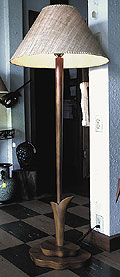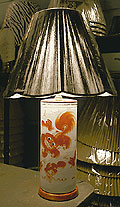By Mike Leidemann
Advertiser Staff Writer
Cliff Garcia and Eddie Iwaida can make a lamp for you out of just about anything.
 |
| This lamp from Tropical Lamp & Shade is custom- made from koa.
Richard Ambo • The Honolulu Advertiser |
Glass balls. Beer and whiskey bottles. A clarinet. Lauhala baskets. An old clam shell. Figurines. Anything.
"The strangest request I ever had was for a boot," Iwaida said.
Like an old Army boot or a women’s high-top boot?
"Just your everyday old boot," Iwaida said.
In similarly cluttered shops just a few blocks away from each other in the still-to-be-gentrified part of Kaka‘ako, Garcia and Iwaida make lamps and lampshades the old-fashioned way. By hand.
At the Tropical Lamp & Shade Co. on Queen Street, Garcia works in the same Quonset hut where is father, James, started the business in 1944.
Using tools and techniques from another era, Garcia works surrounded by hoops, wires, frames and dozens of patterns that can be shaped into lamps and shades of every variety. Custom-made lamps ranging from 6 inches to 6 feet tall are scattered everywhere in a front showroom, while several back rooms are used for storing hardware and fabricating shades.
If anything, Iwaida’s store, Toni’s Lamps & Shades Ltd. on Kona Street, is even more cluttered. Not only is every square inch of floor space taken up by lamps and shades, hundreds more - from large globes to little desk-top varieties - hang from the ceiling.
A path leading from door to desk is just wide enough so that people can scoot through sideways.
 |
| A glass ball serves as the base for this custom-made lamp at Tropical Lamp & Shade.
Richard Ambo • The Honolulu Advertiser |
Although most lamps are sold today in lighting stores or big box retailers like Kmart and Lowe’s Hardware, a steady, loyal stream of customers finds its way to both stores when they are looking for something special, something called "quality."
"It’s the quality of the construction that keeps us going," Garcia said. "You can buy a lampshade anywhere these days for $10 or $20, but when you want something special, there aren’t many other places to turn."
Some customers bring their favorite old, broken, battered or just plain worn-out lampshades, hoping to have them brought back to life. Garcia and a helper can rebuild the frames and recover them in any of dozens of laminated materials, from linen to lauhala.
"The key to a good lampshade is covering all the hardware," he said. "You want to hide that and let all the rest of the lamp be shown."
Others come to the store with a single object (antler horns, an old gas meter, a Primo bottle, a piece of koa or driftwood) hoping to have them turned into working lamps. Garcia adds a base, electric hardware and a shade to turn anything into a working piece of art.
Iwaida has been in his Kona Street location for 21 years. Although his shop has almost no street visibility, customers who need a hard-to-replace commercial shade or unique new piece know where to find him. He augments his custom lamp and shade business with as many hard-to-find manufactured pieces as he can squeeze into the shop.
"The old generation appreciates the personal touch," he said.
"The new generation is more willing to accept the mass-produced items."
 |
| A vase forms the base for this lamp from Toni’s Lamps & Shades.
Richard Ambo • The Honolulu Advertiser |
Iwaida and Garcia both know they’re part of a fading breed. They know their business is eroding slowly, falling victim to ever more companies and people who can’t or won’t pay the price for the quality that goes into a handmade or hand-repaired lamp or shade.
Garcia said Waikiki hotels, once a big part of his business, no longer go out of their way to offer hand-crafted furnishings, choosing to buy from the Mainland.
He augments his lamp business by running an auto paints and parts store in an adjacent storefront. He has thought sometimes about getting out of the light business, but "I couldn’t do that. I enjoy working with my hands, like my Dad."
Iwaida, too, struggles to keep up with the times, expanding his business into the new craft areas of fabric-covered and painted lampshades and designer finials, those funny little figures that clamp a lampshade tight to the hardware.
He also recently hired an artist, Maja Vanderveer, to build lampshades and paint them in slow times. She is creating botanical prints on the fine fabric that goes on the custom shades.
"I’m learning as I go," she said. "It’s a slow way to enlightenment."
[back to top] |

 The Great Index to Fun
The Great Index to Fun

